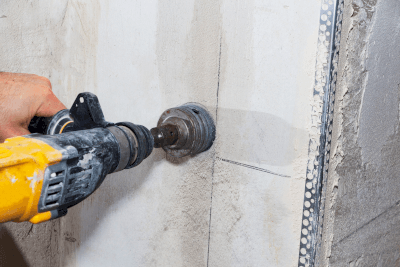What Is a Hole Cutter?

Hole cutters are tools for cutting holes out of sheet materials such as metal, wood, and plastic.
They have circular blades and are available in manual, electric, and mechanical types.
The manual type is easier to drill holes than those using drill bits. The electric type has a stronger cutting force than the manual type and is suitable for drilling large holes and processing hard materials. The mechanical type can feed material automatically and drill holes at high speeds, and can also be used for a wide variety of operations by changing cutter blades to cut holes of different diameters.
Uses of Hole Cutters
1. Wood Processing
Drilling holes for wiring in ceilings, drilling holes for installing ventilation fans in kitchens and toilets, etc.
2. Metal Processing
Drilling holes to thread bolts into automobile and aircraft panels, drilling holes to install water and gas pipes, etc.
3. Construction and Interior Work
Drilling holes for wiring and piping, drilling holes for interior furniture installation, etc.
4. Civil Engineering Work
Drilling holes to fix fences and signs, drilling holes to install road signs, etc.
5. Medical Equipment
Drilling holes in plastic and metal instruments, etc.
6. Paper Manufacturing/Paper Processing
Hole punching of paper, etc.
Types of Hole Cutters
The following types of hole cutters are available.
1. Manual Type
This tool has a circular blade and is used to cut the material to be processed manually. Since it is a manual tool, its processing accuracy is slightly less than that of mechanical or electric tools, but it is low-priced and easy to use.
2. Electric-Powered Type
Electric hole cutters are suitable for drilling large holes and processing hard materials, as they have stronger cutting power than the manual type.
3. Mechanical Type
Mechanical hole cutters are able to feed material automatically and drill holes at a high speed. They are suitable for mass production at production sites and for precision machining.
4. Core Drill
Core drills are hole cutters for cutting out large-diameter holes. The center of the hole is set by the drill bit attached to the center, and the surrounding area is cut out by the blade.
5. Chamfering Hole Cutter
Chamfering hole cutters are used to process the end face after drilling. The beveling hole cutter has an angled cutting edge, and the end face is chamfered while the chips are discharged, resulting in a clean machined surface.
6. Step Drill
A step drill is a type of hole cutter that can expand a hole in stages. While a normal hole cutter cuts a hole of a fixed diameter at a time, a step drill is a drill bit with multiple steps of different diameters, allowing the hole to be expanded step by step.
Principle of Hole Cutters
In general, hole cutters can drill holes accurately and efficiently by adjusting the rotational speed and rate of progression. It is important to select the appropriate cutting edge and processing conditions according to the hardness and thickness of the material to be processed.
- Hole Positioning
Determine the hole position and bring the hole cutter into contact with the material to be processed. - Rotation
Rotate the cutting edge of the hole cutter. - Cutting
The cutting edge cuts into the material, the material is cut, and the cut material is taken into the hole cutter to form the hole. A depth-limiting ring is used as necessary to drill the hole to the required depth. - Chip Removal
Drilling is completed by advancing the cutting edge until the hole is completely drilled. Remove the chips and remove the hole cutter from the material.
Features of Hole Cutter
Advantages
The cutting edge rotates, enabling high-speed drilling. The circular shape of the cutting edge enables accurate positioning for high-precision drilling.
The hole cutter uses a hard material for the cutting edge, making it possible to work with hard materials such as iron and stainless steel. Since a large hole can be cut through at one time, larger diameter holes can be drilled than with conventional drill bits. The end face of the hole after cutting is perpendicular to the cutting surface, resulting in a beautiful finish.
Hole cutters can drill holes up to a certain depth by using a depth-limiting ring (stopper function). In addition, many of the cutting edges are removable for easy replacement, and the cutting edges are made of a hard material for superior durability.
Disadvantages
Due to the limited strength of hole cutters, they may not be able to cut through very large holes, or they may not be able to cut holes beyond a certain depth due to the vibration produced by the hole cutter.
In addition, hole cutters can cut through a large hole at a time, but this may cause burrs to form around the hole. In such cases, the burrs need to be removed.
Other Information on Hole Cutters
About the Pre-drilled Hole
When drilling a hole with a hole cutter, a pre-hole may be required. A pre-hole is a small hole that is drilled to facilitate insertion of the cutting edge.
The pre-hole reduces vibration during cutting, prevents the cutting edge from breaking, and improves drilling accuracy and speed by allowing the hole cutter’s cutting edge to enter the material more smoothly. To reduce vibration, drill a pre-drilled hole with a drill bit or center punch.